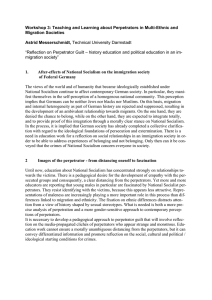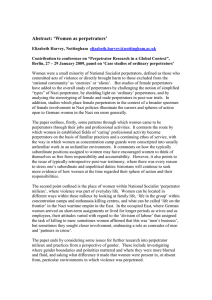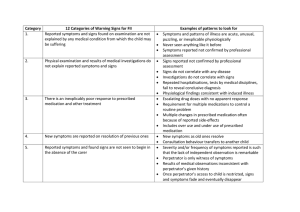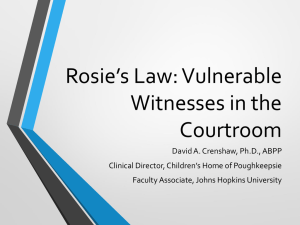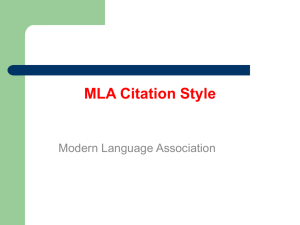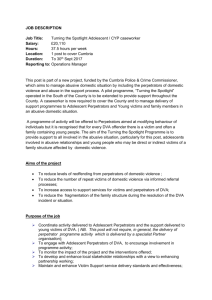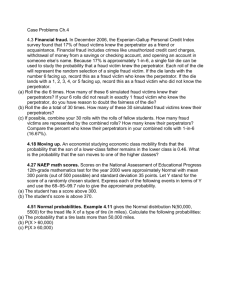Workshop 1: Teaching and Learning about Perpetrators in Schools and... Formal Education Falk Pingel, Braunschweig
advertisement
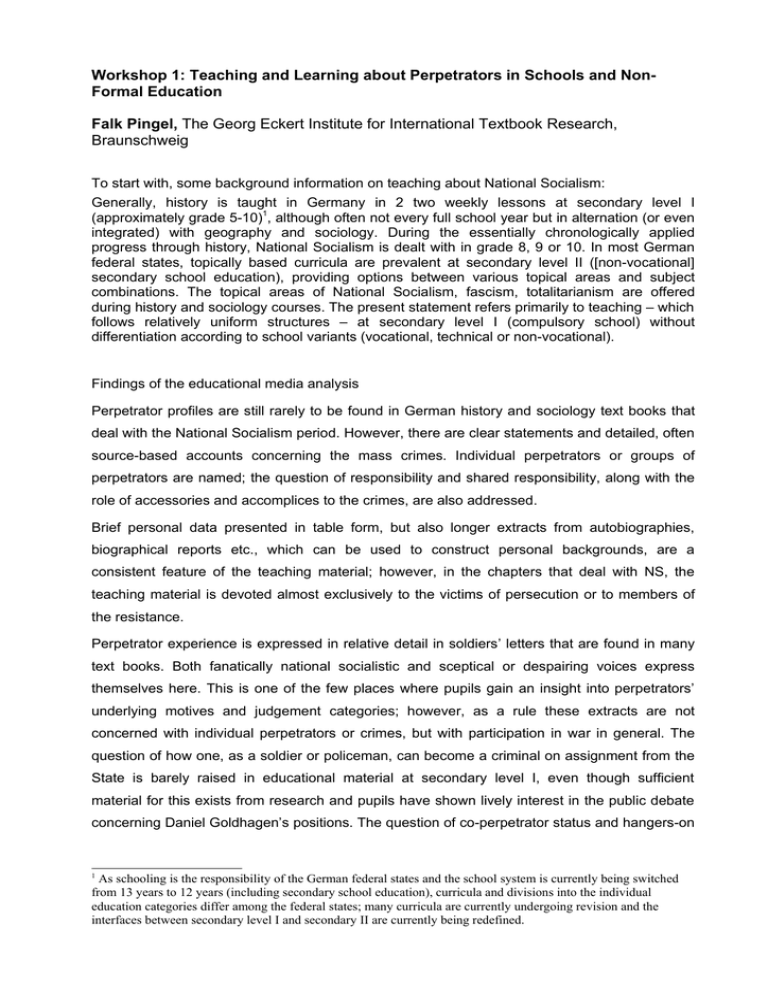
Workshop 1: Teaching and Learning about Perpetrators in Schools and NonFormal Education Falk Pingel, The Georg Eckert Institute for International Textbook Research, Braunschweig To start with, some background information on teaching about National Socialism: Generally, history is taught in Germany in 2 two weekly lessons at secondary level I (approximately grade 5-10)1, although often not every full school year but in alternation (or even integrated) with geography and sociology. During the essentially chronologically applied progress through history, National Socialism is dealt with in grade 8, 9 or 10. In most German federal states, topically based curricula are prevalent at secondary level II ([non-vocational] secondary school education), providing options between various topical areas and subject combinations. The topical areas of National Socialism, fascism, totalitarianism are offered during history and sociology courses. The present statement refers primarily to teaching – which follows relatively uniform structures – at secondary level I (compulsory school) without differentiation according to school variants (vocational, technical or non-vocational). Findings of the educational media analysis Perpetrator profiles are still rarely to be found in German history and sociology text books that deal with the National Socialism period. However, there are clear statements and detailed, often source-based accounts concerning the mass crimes. Individual perpetrators or groups of perpetrators are named; the question of responsibility and shared responsibility, along with the role of accessories and accomplices to the crimes, are also addressed. Brief personal data presented in table form, but also longer extracts from autobiographies, biographical reports etc., which can be used to construct personal backgrounds, are a consistent feature of the teaching material; however, in the chapters that deal with NS, the teaching material is devoted almost exclusively to the victims of persecution or to members of the resistance. Perpetrator experience is expressed in relative detail in soldiers’ letters that are found in many text books. Both fanatically national socialistic and sceptical or despairing voices express themselves here. This is one of the few places where pupils gain an insight into perpetrators’ underlying motives and judgement categories; however, as a rule these extracts are not concerned with individual perpetrators or crimes, but with participation in war in general. The question of how one, as a soldier or policeman, can become a criminal on assignment from the State is barely raised in educational material at secondary level I, even though sufficient material for this exists from research and pupils have shown lively interest in the public debate concerning Daniel Goldhagen’s positions. The question of co-perpetrator status and hangers-on 1 As schooling is the responsibility of the German federal states and the school system is currently being switched from 13 years to 12 years (including secondary school education), curricula and divisions into the individual education categories differ among the federal states; many curricula are currently undergoing revision and the interfaces between secondary level I and secondary II are currently being redefined. from broad sections of the population is generally answered with a reference to societal pressure to conform. Perpetrator profiles are not drawn up. This finding requires an explanation. Personal accounts, source-based biographical reports etc. have been a feature of German school text books since about the middle of the 1960s; in contemporary history they are found particularly with reference to National Socialism, and primarily in order to render the victims’ fate accessible to pupils, to generate empathy, to prompt understanding for the difficult and rare decision to put up active resistance. This placement of emphasis – new at the time – is understandable, as this was the way in which more awareness of persecution and resistance was to be achieved; for, in the 1950s, the murder of Jews and of other persecuted groups was sometimes not even mentioned in curricula and educational materials, or dealt with only very cursorily and often not discussed in class. Although this justification no longer applies today, the finding has not changed significantly. I would very much like to use the workshop in order to discuss possible reasons for this. I offer the following hypotheses: 1. There continues to exist a stance – educationally founded and influenced by the political climate of “redress” – to have the victims met with justice, not to have them “disappear” in a voiceless mass of murdered people, but to individualise their fate. 2. There exists the fear of exposing oneself to the accusation of levelling or parallelisation when the method of individualisation is also applied in order to “understand” the life stories of perpetrators. 3. “Understanding perpetrators” is – particularly in class with young people – an incomparably more difficult concept than developing empathy with the victims. In terms of history-teaching material, more attention has been paid to understanding repression, discrimination and suffering than to the reasons for perpetrator status in a criminal political system. 4. A perpetrator life story could render the deed comprehensible and explicable, which could lead to the misunderstanding that the deed is thus also excusable. 5. Space and means of expression in educational material, as well as time during lessons, are limited. Dealing with life stories requires time and constitutes a particular kind of methodical approach. For “reasons of economy” the attempt is not made to apply this approach to the description of victims and perpetrators; the victim perspective is meant to take priority over the perpetrator perspective. The finding for history text books at secondary level II looks different. Research by Browning and Goldhagen has occasionally found its way in here. 2 Here too, however, the authors do not 2 Dirk Hoffmann/Friedhelm Schütze: Weimarer Republik und nationalsozialistische Herrschaft, Schöningh/Schroedel: Paderborn 1999 (history lessons for secondary level II), p. 246-51, portray the Goldhagen / Browning controversies on the basis of extracts from their publications and of statements by historians. Zeiten und Menschen 2, Geschichte Oberstufe, Schöningh/Bildungshaus text-book publishers: Braunschweig 2006, p. 186f., go so far as to let the perpetrators speak for themselves or to draw up perpetrator biographies / profiles, but they choose the meta-level of the debate which is conducted among the experts. The extracts in Hoffmann/Schütze (see note 2) are, however, sufficiently concrete in order, for example, to explain the question whether one can “become habituated to” taking part in mass murder. Conclusion The description in educational material of the stages of the persecution, from “slander” to “genocide”, and of its instruments (from laws through to individual terror) provides good ground for inserting perpetrator biographies into the texts. Perpetrator groups or, respectively, organisations (SS, Wehrmacht, party) and perpetrators in positions of leadership (a brief life story concerning Hitler can also be found now and again) 3 are named clearly anyway. The course of deeds is also frequently “substantiated” by detailed perpetrator quotes (this applies in particular to the process of gassing; Höß is presumably, followed by Anne Frank, the mostquoted person in history books on contemporary history). A description of the deed from the victims’ perspective is not always compared with the perpetrator’s account. The development of material which can be utilised easily by text-book authors would be helpful. Corresponding workbooks of material should also contain instructional references, in which – among other things – potential counter-arguments are dealt with. cited in detail from a lecture by H.-U. Wehler on the question why not more Germans put up resistance to the criminal orders. Geschichte und Geschehen, Neuzeit, Sekundarstufe II, Klett: Leipzig, 2005, p. 228, provides a halfpage summary of the debate under the heading, “Totally normal men”. 3 Entdecken und Verstehen, Realschule Bayern, Cornelsen: Berlin 2003, p. 158, devotes one page to answering the question, “Who was Adolf Hitler?” with biographical details which, however, only extend up to 1925. At the end there is the question for study: “Are there events in Hitler’s life that surprise you or which you don’t understand?” It is not apparent to me whether this is merely a comprehension question or whether it is intended to provide an impulse for further consideration. The book, and particularly the section on NS seizure of power, is unusually Hitler-focused. A brief overview of the life of Gertrud Scholtz-Klink in Forum Geschichte 2, Nordrhein-Westfalen, Cornelsen: Berlin 2003 consists essentially of data which in no way allow conclusions concerning the decisive moments in his life story. Not much more productive is the long extract from the autobiography of Nicht Melita Maschmann in Horizonte 9, Geschichte Gymnasium Hessen, Westermann/Bildungshaus text-book publishers: Braunschweig 2008, p. 125.
